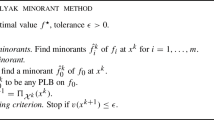Abstract
The basic theorm of (linear) complementarity was stated in a 1971 paper [6] by B.C. Eaves who credited C.E. Lemke for giving a constructive proof based on his almost complementary pivot algorithm. This theorem asserts that associated with an arbitrary linear complementarity problem, a certain augmented problem always possesses a solution. Many well-known existence results pertaining to the linear complementarity problem are consequences of this fundamental theorem.
In this paper, we explore some further implications of the basic theorem of complementarity and derive new existence results for the linear complementarity problem. Based on these results, conditions for the existence of a solution to a linear complementarity problem with a fully-semimonotone matrix are examined. The class of the linear complementarity problems with aG-matrix is also investigated.
Similar content being viewed by others
References
M. Aganagić and R.W. Cottle, “A constructive characterization ofQ o-matrices with nonnegative principal minors,”Mathematical Programming 37 (1987) 223–231.
R.W. Cottle, “Solution rays for a class of parametric linear complementarity problems,”Mathematical Programming Study 1 (1974) 59–70.
R.W. Cottle and R.E. Stone, “On the uniqueness of solutions to linear complementarity problems,”Mathematical Programming 27 (1983) 191–213.
B.C. Eaves, “The linear complementarity problem,”Management Science 17 (1971) 612–634.
B.C. Eaves, “On quadratic programming,”Management Science 17 (1971) 698–711.
B.C. Eaves, “On the basic theorem of complementarity,”Mathematical Programming 1 (1971) 68–75.
C.B. Garcia, “Some classes of matrices in linear complementarity theory,”Mathematical Programming 5 (1973) 299–310.
M.S. Gowda, “On copositive linear complementarity problems,” Research Report, Department of Mathematics and Statistics, University of Maryland Baltimore County (Baltimore, MD, 1987).
M.S. Gowda, “Pseudomonotone and copositive star matrices,”Linear Algebra and its Applications 113 (1989) 107–118.
P.T. Harker and J.S. Pang, “Finite-dimensional variational inequality and nonlinear complementarity problems: a survey of theory, algorithms and applications,”Mathematical Programming (Series B) 48 (1990) 161–220.
S. Karamardian, “Generalized complementarity problem,”Journal of Optimization Theory and Applications 8 (1971) 161–168.
S. Karamardian, “The complementarity problem,”Mathematical Programming 2 (1972) 107–129.
S. Karamardian, “Complementarity problems over cones with monotone and pseudomonotone maps,”Journal of Optimization Theory and Applications 18 (1976) 445–454.
S. Karamardian, “An existence theorem for the complementarity problem,”Journal of Optimization Theory and Applications 19 (1976) 227–232.
M. Kojima, “A unification of the existence theorems of the nonlinear complementarity problem,”Mathematical Programming 9 (1975) 257–277.
C.E. Lemke, “Bimatrix equilibrium points and mathematical programming,”Management Science 11 (1965) 681–689.
C.E. Lemke, “On complementary pivot theory,” in: G.B. Dantzig and A.F. Veinott, Jr., eds.,Mathematics of Decision Sciences, Part I (American Mathematical Society, Providence, RI 1968) pp. 95–14.
J.S. Pang, “OnQ-matrices,”Mathematical Programming 17 (1979) 243–247.
J.S. Pang, “Iterative descent methods for a row sufficient linear complementarity problem,”SIAM Journal on Matrix Analysis and Applications 12 (1991) 611–624.
J. Parida and K.L. Roy, “A note on the linear complementarity problem,”Opsearch 18 (1981) 229–234.
R.T. Rockafellar,Convex Analysis (Princeton University Press, Princeton, NJ, 1970).
R.E. Stone, “Geometric aspects of the linear complementarity problem,” Ph.D. thesis, Department of Operations Research, Stanford University (Stanford, CA, 1981).
Author information
Authors and Affiliations
Additional information
The work of this author was based on research supported by the National Science Foundation under grant ECS-8717968.
Rights and permissions
About this article
Cite this article
Gowda, M.S., Pang, JS. The basic theorem of complementarity revisited. Mathematical Programming 58, 161–177 (1993). https://doi.org/10.1007/BF01581265
Received:
Revised:
Issue Date:
DOI: https://doi.org/10.1007/BF01581265




